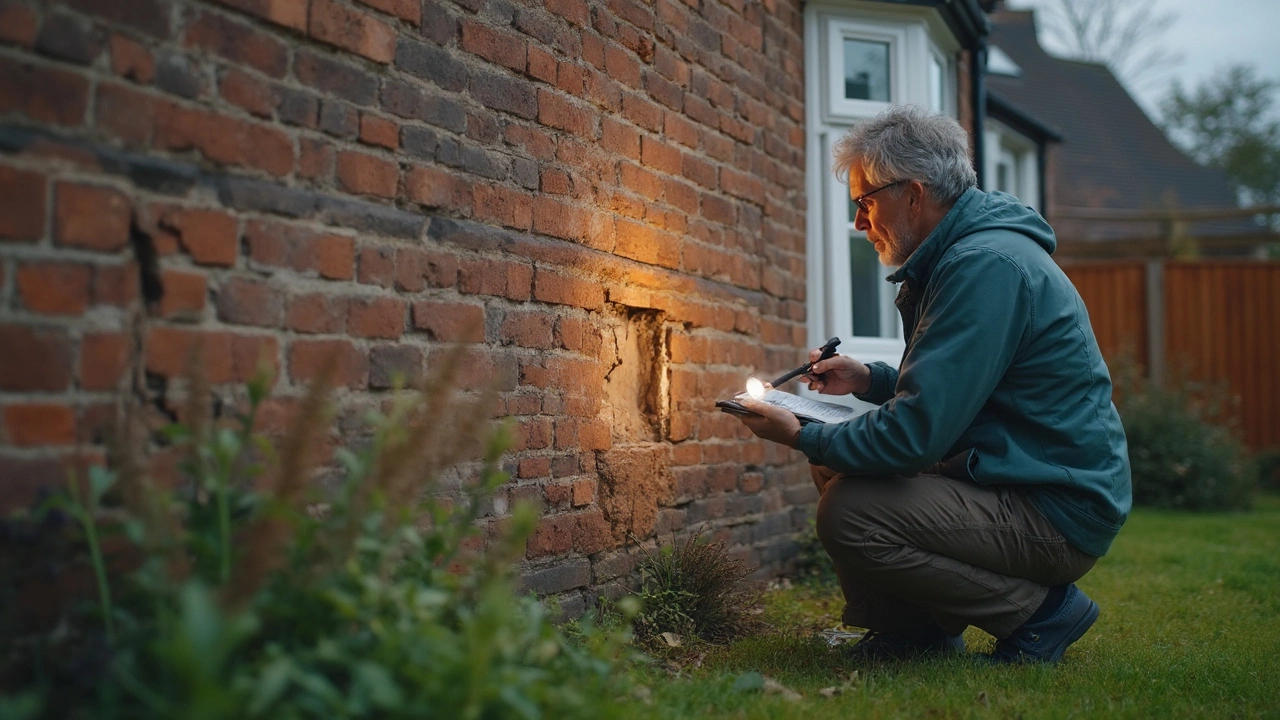Most people picture heavy machinery and sky-high bills when they hear about foundation repair. Here's the thing, though: you don't always need to lift your house to deal with sinking floors, cracked walls, or that annoying door that sticks. Plenty of problems can be tackled while your home sits comfortably on its base.
The secret? There's a whole toolkit of methods for fixing foundation issues from the sides, from inside, and even from underneath, without jacking up anything besides your sleeves. We're talking about crack injections, foam injections, pier repairs, and surface drainage tweaks—solutions that keep everything steady and safe without the crazy costs of a full lift.
Before you start stressing about bulldozers pulling up to your driveway, let's look at how you can get your foundation sorted while life inside the house keeps rolling along. Not every crack or sag means major surgery. Sometimes, it's surprising how simple a fix can be.
- Why People Think Lifting Is Needed
- Common Foundation Problems That Don’t Require Lifting
- Proven Fixes Without Moving the House
- Red Flags: When Simple Fixes Aren’t Enough
Why People Think Lifting Is Needed
Whenever someone sees a major crack or slope in their floor, their mind jumps to the worst-case scenario—like pictures online where a whole house is literally lifted by outsized jacks. That image sticks because, yes, lifting was the go-to method in the past for most major foundation repair jobs. Contractors used to raise the whole place up to get access to damaged slabs or footings, especially if the problem was big or the foundation had sunk a lot.
People also get scared by stories of houses suddenly splitting or leaning in after a big crack appears. Home improvement TV shows often make it look like lifting is the only fix for these serious issues. Plus, some folks get told by well-meaning friends or old-school handymen that “there’s no other way.”
Another big reason: insurance companies and inspectors often list foundation settlement, shifting, or wall failure as major red flags, so homeowners get the impression that only dramatic repairs—like lifting—will do the trick.
But here’s a reality check. Lifting the house is only required in extreme cases, mostly when the foundation’s dropped several inches or collapsed due to erosion or really unstable soil. For tons of common foundation cracks and mild settling, modern repairs don’t involve raising your house at all.
To put things in perspective, check out this quick table comparing the situations:
| Foundation Problem | Needs Lifting? |
|---|---|
| Small cracks in slab or wall | No |
| Minor uneven settling | No |
| Floor out of level by < 1 inch | No |
| Foundation sunk in one area (several inches) | Sometimes |
| Severe collapse or broad shifting | Yes |
So next time someone jumps to ‘lifting,’ remember: most regular foundation repair jobs can be done with way less drama and cost.
Common Foundation Problems That Don’t Require Lifting
A lot of folks panic when they spot cracks or a little settling around the house, thinking it means disaster. But not all foundation repair jobs demand house lifting. Let’s talk about some of the problems you can fix with your house right where it is.
First up: hairline cracks. These are those slim cracks you see running along basement walls or floors. In most cases, these come from concrete shrinking as it dries and don’t threaten the structure. You can handle these with an epoxy or polyurethane injection. These materials fill the gap and seal out water, which helps prevent bigger issues down the road.
Another common problem is minor settling. All homes settle a little, especially in the first few years. If your floors have a slight slope or if you notice small cracks above doors and windows, you’re probably dealing with regular settling—not a sinking ship. Spot repairs, like sealing or patching, can do the trick here. There’s no need to panic or bring in heavy machinery.
Water is a sneaky troublemaker. If you see water pooling near your foundation, it can cause erosion or even lead to small cracks. Usually, this is more about drainage than actual slab issues. Adding a simple French drain, cleaning your gutters, or grading your yard so water moves away from the home can solve the problem without touching the house itself.
- Foundation cracks (vertical or hairline): Fill with injection methods, no lifting needed.
- Sticky doors and windows: Usually linked to small shifts—can be fixed with targeted bracing or shimming.
- Small gaps around pipes: Use caulk or foam sealant to keep pests and water out.
Check out this quick table on which common issues can be fixed with simple non-lifting methods:
| Problem | Quick Fix | House Lifting Needed? |
|---|---|---|
| Tiny wall/floor cracks | Epoxy/Polyurethane injection | No |
| Pooling water at foundation | Improve drainage, French drains | No |
| Sticking doors/windows | Shim or re-align | No |
If things are shifting fast, or cracks keep getting bigger, that's a different ballgame. But for simple cracks, minor settling, and drainage headaches, you’ve got a bunch of straightforward tools at your disposal—no jacks required.

Proven Fixes Without Moving the House
Cracks and dips in your foundation don't always mean you need to jack up your home. There are straightforward ways pros fix problems while your house stays put. The trick is matching the right solution to the issue.
Here are some tried-and-true methods:
- Epoxy or Polyurethane Injections: Got hairline cracks in your concrete slab or basement walls? Epoxy and polyurethane foams fill them right up. The process is fast and doesn’t even mess up your paint job. Polyurethane is great for leaks, since it expands and seals out water. Epoxy binds the crack tightly, often restoring the strength of the original concrete. You’re looking at about $350–$1,200 per crack for a professional job, depending on the length and location.
- Slabjacking (Mudjacking) or Polyjacking: If part of your slab or sidewalk is sinking—think sunken front steps or corners of a garage—specialists can pump a mix of mud or lightweight foam underneath to lift it back to normal. No heavy equipment needed on top of the house. Slab issues like these are super common and usually fixed in a few hours.
- Pier and Beam Repairs: Older homes with crawl spaces might sag in places. Crawl under (or hire someone) and replace rotten beams, add extra supports (piers), or shim what's there. No lifting of the main structure needed unless damage is extreme. This keeps things stable for decades.
- Improving Drainage and Grading: A lot of foundation repair headaches can be solved by stopping water from pooling around the house. Gutters, downspouts, and regrading the soil can save thousands in repairs. Poor drainage is an underrated cause of foundation cracks.
- Carbon Fiber Straps: If foundation walls are bowing—even a few inches—contractors often use carbon fiber straps bonded to the wall. This method adds major tension hold without any digging outside or lifting. It's quick, clean, and not as pricey as big structural work.
Here's a quick look at the cost and time for each method, so you get a sense of what to expect:
| Fix Type | Typical Cost Range | Average Time Needed |
|---|---|---|
| Crack Injection | $350–$1,200 | 2–6 hours |
| Slabjacking/Polyjacking | $500–$2,500 | 1–4 hours |
| Pier/Beam Repair | $1,000–$4,000 | 1–2 days |
| Drainage Fixes | $500–$3,000 | Half a day to 2 days |
| Carbon Fiber Straps | $350–$600 per strap | 2–5 hours |
If you’re seeing cracks or settled spots and the doors and windows still work fine, these fixes usually do the trick. The best part? You stay comfy inside—no moving the family or the furniture.
Red Flags: When Simple Fixes Aren’t Enough
So you’ve tried patching up those cracks and adjusting the doors, but things still don’t feel right. Sometimes, just sealing a gap or pumping in foam under your slab isn’t going to cut it. There are a few clear signs that your foundation needs more attention than these quick fixes. Ignoring them can turn a manageable problem into a money pit.
Here are the most common warning signs that simple foundation repair solutions aren’t enough:
- Big, jagged cracks in walls or ceilings, especially if they're wider than a quarter inch or keep getting longer.
- Sticking windows and doors throughout the house, not just in one spot. If you can’t even get a couple of them to budge, something’s moving underneath.
- Bulging or bowing walls, often seen in basements or crawl spaces. That’s not just cosmetic—it could mean soil pressure is pushing your foundation in.
- Gaps between walls and floors or ceilings that weren’t there before. If you can see daylight or feel a breeze, it isn't just drafty weather.
- Water coming in where it shouldn’t—especially after rain—or mold appearing on lower walls. This hints at shifting slabs or incomplete sealing that’s let moisture through.
Sometimes, the real danger isn’t visible—soil movement under the home can lead to sudden, extreme settling. According to repair specialists, if one side of the house sinks more than 2 inches compared to the other side, slab issues have probably become severe.
| Red Flag | What It Means |
|---|---|
| Wider than 1/4" crack | Potential structural shift; not just surface settling |
| Doors/windows won't close at all | Likely major movement of foundation or frame |
| Bowed basement wall | Excess soil pressure, possible collapse risk |
If these sound familiar, patch jobs and slab issues solutions won’t be enough. These situations call for licensed pros—soil stabilization, deep pier systems, or even partial house lifting right up to where the trouble is. It’s better to act fast before that small crack becomes a major headache.
Bottom line: keep an eye on these warning signs. Not every issue needs a full-scale repair, but when the big red flags show up, it’s smart to pick up the phone before minor problems take a major bite out of your wallet.





